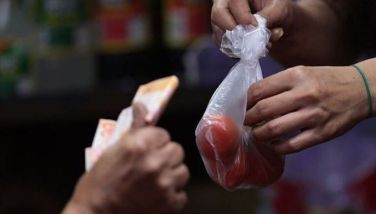‘White alert’ in DOH hospitals
December 27, 2006 | 12:00am
The Department of Health (DOH) has placed the staff of all 72 hospitals under its supervision on highest alert status to prepare for fireworks-related injuries and untoward incidents during the New Year celebration.
The DOH raised the "Code White" alert status on government hospitals to be ready for the expected deluge of victims of firecracker explosions and stray bullets, especially on the evening of Dec. 31.
Under Code White, hospitals must ensure that they have enough manpower and medical supplies that can be used to attend to patients.
This developed as the DOH said that 52 more firecracker-related injuries were reported on Christmas Day. The patients included watusi-poisoning victims, residents hit by stray bullets and victims of exploding improvised cannons made of PVC pipes called boga. This brings to 124 the number of injuries reported since Dec. 20.
DOH chief epidemiologist Dr. Eric Tayag said 10 victims of stray bullets were recorded by the DOH National Epidemiology Center (NEC) on Christmas Eve.
The first casualty of a stray bullet this year was a 37-year-old woman from Quezon City who was hit last Dec. 23.
Tayag noted the DOH is coordinating with the Philippine National Police to formulate strategies that would prevent the indiscriminate firing of guns by revelers.
NEC records showed that injuries caused by PVC plastic cannons also reached 25 cases with 17 of the victims sustaining eye injuries.
Officials said when a PVC cannon fails to fire, the user tends to open the cover and peek through the pipe, which later explodes.
Tayag claimed that after the PVC cannon fires, it takes several seconds before the cannon can be used again because of the smoke inside the pipe.
"They (users) usually blow out the smoke. They just can’t wait so in the process they get injured," Tayag said.
The DOH is now in the process of identifying areas where most of the PVC cannon-related injuries come from so the agency could conduct a massive information campaign against the danger of the plastic cannons.
"We also recorded one more case of watusi poisoning so we now have two cases. We reiterate our call to parents not to allow their kids to play with watusi. Watusi may appear safe because they look like candy but they are toxic," he added.
The Manila Police District urged parents to stop children from using PVC cannons that are not yet included in list of banned fireworks.
MPD officer-in-charge Senior Superintendent Danilo Abarzosa advised parents to keep their children away from PVC cannons to avoid injuries.
Abarzosa said with the absence of a law governing the popular PVC cannons, issuing a warning to the citizens is the best thing the police can do.
"While there may be regulations against powerful illegal firecrackers such as pla-plas, super lolos, and whistle bombs, there are no rules governing PVC cannons because it uses denatured alcohol and not gunpowder used in firecrackers," said Abarzosa.
Abarzosa ordered policemen to go around communities to discourage children from playing with dangerous firecrackers and just use the less dangerous sparklers like Roman candles and luces. - With Evelyn Macairan
The DOH raised the "Code White" alert status on government hospitals to be ready for the expected deluge of victims of firecracker explosions and stray bullets, especially on the evening of Dec. 31.
Under Code White, hospitals must ensure that they have enough manpower and medical supplies that can be used to attend to patients.
This developed as the DOH said that 52 more firecracker-related injuries were reported on Christmas Day. The patients included watusi-poisoning victims, residents hit by stray bullets and victims of exploding improvised cannons made of PVC pipes called boga. This brings to 124 the number of injuries reported since Dec. 20.
DOH chief epidemiologist Dr. Eric Tayag said 10 victims of stray bullets were recorded by the DOH National Epidemiology Center (NEC) on Christmas Eve.
The first casualty of a stray bullet this year was a 37-year-old woman from Quezon City who was hit last Dec. 23.
Tayag noted the DOH is coordinating with the Philippine National Police to formulate strategies that would prevent the indiscriminate firing of guns by revelers.
NEC records showed that injuries caused by PVC plastic cannons also reached 25 cases with 17 of the victims sustaining eye injuries.
Officials said when a PVC cannon fails to fire, the user tends to open the cover and peek through the pipe, which later explodes.
Tayag claimed that after the PVC cannon fires, it takes several seconds before the cannon can be used again because of the smoke inside the pipe.
"They (users) usually blow out the smoke. They just can’t wait so in the process they get injured," Tayag said.
The DOH is now in the process of identifying areas where most of the PVC cannon-related injuries come from so the agency could conduct a massive information campaign against the danger of the plastic cannons.
"We also recorded one more case of watusi poisoning so we now have two cases. We reiterate our call to parents not to allow their kids to play with watusi. Watusi may appear safe because they look like candy but they are toxic," he added.
The Manila Police District urged parents to stop children from using PVC cannons that are not yet included in list of banned fireworks.
MPD officer-in-charge Senior Superintendent Danilo Abarzosa advised parents to keep their children away from PVC cannons to avoid injuries.
Abarzosa said with the absence of a law governing the popular PVC cannons, issuing a warning to the citizens is the best thing the police can do.
"While there may be regulations against powerful illegal firecrackers such as pla-plas, super lolos, and whistle bombs, there are no rules governing PVC cannons because it uses denatured alcohol and not gunpowder used in firecrackers," said Abarzosa.
Abarzosa ordered policemen to go around communities to discourage children from playing with dangerous firecrackers and just use the less dangerous sparklers like Roman candles and luces. - With Evelyn Macairan
BrandSpace Articles
<
>
- Latest
- Trending
Trending
Latest
Trending
Latest
Recommended

































